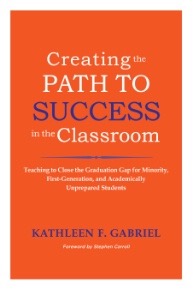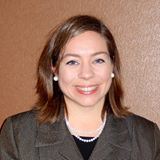pedagogical strategies
Select an item by clicking its checkbox
As the fall semester draws to a close, I reflect on how our classrooms continue to absorb the dense impact of exhaustion, grief, and so many unknowns. The isolation and physical distancing brought by COVID-19 during the first months of 2020 have remained a reality for much longer than any of ...

Creating the Path to Success in the Classroom: Teaching to Close the Graduation Gap for Minority, First-Generation, and Academically Unprepared Students
Date Reviewed: October 8, 2018
Kathleen Gabriel’s Creating the Path to Success in the Classroom is a clear, engaging, and practical book that will be of use to anyone teaching in a university or community-college classroom.
In his forward to the book, Stephen Caroll praises Gabriel’s “deep integration of theory and practice” (xiii). This integration is one of the book’s major strengths. Gabriel introduces the reader to scholarship on barriers to student learning, student mindsets, and effective pedagogy. Extensively referenced and cited, Gabriel’s book is thus a primer on classic and more recent scholarship of teaching and learning. After describing this scholarship, Gabriel then offers practical suggestions of classroom strategies designed to engage students effectively given the data. These range from one-time strategies – reading a particular article on growth mindsets as a class, doing an active-learning activity – to strategies that unfold over the course of an entire semester. Gabriel offers concrete scripts for welcoming students and setting a classroom tone, giving student feedback that encourages persistence and growth, creating and shuffling small groups, and much more. Gabriel not only suggests what to do and why, but also encourages faculty to make those reasons explicit to students, making students intentional partners in their own learning.
Gabriel explores strategies for creating a positive classroom climate during the first days of class, engaging students during the first month of the semester, growth mindsets and mental toughness, creating interactive lectures, motivating students to read, think about, and discuss course readings, integrating critical thinking and writing into class activities and assignments, and developing student resilience and persistence. In four appendices, Gabriel offers even more practical suggestions. For example, in her chapter on classroom climate, Gabriel notes that “one way that professors can increase their own cultural competence is to read both nonfiction and fiction material that addresses multicultural issues” (20). Gabriel then directs the reader to Appendix A, a list of nonfiction and fiction readings by authors of color that helped her expand her own “cultural competence and awareness” (131).
Gabriel is gentle in encouraging faculty to teach minority, first-generation, and academically unprepared students more effectively, suggesting incremental steps that faculty can take as they become more comfortable with new pedagogical strategies. She insists throughout that inclusive pedagogy not come at the expense of a rigorous academic standards: “We can design our assignments in a way that holds students to high standards, but, at the same time, we can give all our students encouragement, support, and resources so that they have ample opportunity to achieve those standards” (111).
Creating the Path to Success in the Classroom will be helpful to teaching veterans and novices alike. In her opening chapter, Gabriel frames the book as designed to help faculty effectively teach and retain minority, first-generation, and academically unprepared students. As is the case with many implementations of universal design principles, however, these strategies ultimately improve student engagement and learning for all students.

Flipped Instruction: Breakthroughs in Research and Practice
Date Reviewed: July 3, 2018
In many traditional classrooms, the teacher uses lectures to transmit course content to students. A “flipped” classroom is one in which a teacher presents lectures and delivers other course content outside of class (for example, via video- or audio-recorded and written instruction) and prioritizes activities, discussion, and higher-level analytical thinking during class time. Flipped Instruction: Breakthroughs in Resource and Practice offers readers the latest theories, strategies, and pedagogies on flipping classrooms. Bringing together thirty-seven contributors from seven countries, thirty-two colleges and universities, four high schools, and one institute, it presents “a comprehensive collection of research on the latest findings” on flipped teaching and learning in order to provide “researchers, practitioners, and all audiences with a complete understanding of the development of applications and concepts surrounding these critical issues.” (ix)
Each contributor operates under the assumption that flipping a classroom in a professional and pedagogically informed manner begets educational gains that far exceed the costs of time investment, technological learning curves, and pedagogical challenges. In chapter 4, David Starr-Glass makes a memorable statement about the benefits by explaining that a flipped classroom “changes a teacher-centered process to a student-centered one. The ‘sage on the stage’ becomes the ‘guide on the side,’ with a shift from transmission to learners to a flow among and between learners.” (51, emphasis in original).
This book addresses nearly every domain where flipped teaching has made significant inroads: K-12 education, higher education, online, ESL, and foreign language education. Its twenty-four chapters are organized into four main sections. Section 1 (Chapters 1-6) addresses course design methodology and how the latest pedagogies impact flipped classrooms. Section 2 (Chapters 7-12) discusses the unique challenges and opportunities of flipping ESL and foreign language learning classrooms. Section 3 (Chapters 13-20) considers flipped instruction in higher education. Section 4 (Chapters 21-24) offers the latest curriculum developments in K-12 education.
Flipped Instruction accomplishes its goal of providing educators with a comprehensive resource on the latest research in theory and practice. It also strikes a nice balance between being academically-oriented and practitioner-oriented. Academics will enjoy the book’s emphasis on new theories, pedagogies, and educational innovations, and practitioners will appreciate the takeaways from educational experiments, the rich repository of resources, and the activities to try in the classroom. That stated, the book would serve its readers better if it were more learner-friendly, an ironic weakness since it was written by expert teachers who value learner-centered education. Perhaps under the watchful eye of a single editor, it would exhibit stronger collaboration between authors, be better organized, and would avoid needless repetition (for example, an unusually high number of authors reviewed the history of flipped classrooms).
Teachers of theology and religion who appreciate flipped instruction or who practice it as a pedagogical strategy will appreciate the many resources that Flipped Instruction provides in course design, Internet and computer software ideas, and learning activities. However, the book is not a primer for the uninitiated in flipped teaching and learning. A different book would be a better introduction to the subject.
More than once, a student has reported on a trauma unfolding in real time in the middle of class. Students with laptops open, or phones nearby, have shared breaking news of university lockdowns or school shootings. Just this semester, in the hours surrounding classes, we’ve seen gun violence and ...
In a society wrought with busyness, contemplation is often deemed a foolish waste of time. Yet, for those of us who want to be reflective practitioners of teaching, contemplation is essential. In considering the needs of students who are navigating our frenetic society, perhaps they, too, need to learn to ...


